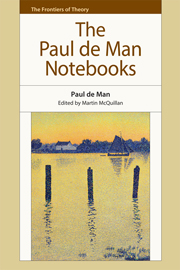Book contents
- Frontmatter
- Contents
- Series Editor's Preface
- Acknowledgements
- Dedication
- Introduction: ‘The Unimaginable Touch of Time’: The Public and Private in the Notebooks of Paul de Man
- PART I Texts
- PART II Translations
- PART III Teaching
- 17 Field of Comparative Literature: Analysis of Needs (1967)
- 18 The Comparative Literature Program at Rutgers University: A Report
- 19 Comparative Literature 816a: Hegel and English Romanticism
- 20 Comparative Literature 816a: Hegel and English Romanticism
- 21 Comparative Literature 817a: Aesthetic Theory from Kant to Hegel
- 22 Curriculum for Lit Z Proposal (1975)
- 23 Literature Z: Exercise II
- 24 Rhetorical Readings
- 25 Director's Report on Rhetorical Reading (1982)
- 26 Seminar on “Aesthetic Theory from Kant to Hegel”. Fall Semester, 1982
- PART IV Research
- Appendix. The Notebooks of Paul de Man 1963–83
- Bibliography
- Index of Names
17 - Field of Comparative Literature: Analysis of Needs (1967)
from PART III - Teaching
Published online by Cambridge University Press: 05 December 2014
- Frontmatter
- Contents
- Series Editor's Preface
- Acknowledgements
- Dedication
- Introduction: ‘The Unimaginable Touch of Time’: The Public and Private in the Notebooks of Paul de Man
- PART I Texts
- PART II Translations
- PART III Teaching
- 17 Field of Comparative Literature: Analysis of Needs (1967)
- 18 The Comparative Literature Program at Rutgers University: A Report
- 19 Comparative Literature 816a: Hegel and English Romanticism
- 20 Comparative Literature 816a: Hegel and English Romanticism
- 21 Comparative Literature 817a: Aesthetic Theory from Kant to Hegel
- 22 Curriculum for Lit Z Proposal (1975)
- 23 Literature Z: Exercise II
- 24 Rhetorical Readings
- 25 Director's Report on Rhetorical Reading (1982)
- 26 Seminar on “Aesthetic Theory from Kant to Hegel”. Fall Semester, 1982
- PART IV Research
- Appendix. The Notebooks of Paul de Man 1963–83
- Bibliography
- Index of Names
Summary
Note: The report follows the general outline proposed by the Department of Education with the addition of one section (Section C, entitled Special Programs). Numbered sections under the headings D and E correspond to the numbered subdivisions of sections C and D in the outline.
Definition and Areas of Priority
Comparative literature has been an established field of study in European and American universities since the end of the nineteenth century: American departments such as Harvard and Columbia trace back their origins to the 1890s. The main expansion, however, took place after the Second World War, prompted by a renewed concern for the international aspects of our culture. By 1952, nine major graduate departments, a professional journal, a yearbook etc. has been established. A second wave of development occurred around 1960, under the impetus of NDEA-financed graduate programs [i.e. under the 1958 National Defense Education Act]. Thirty-seven comparative literature programs and departments are listed in 1963 and the figure has probably doubled since then; at least two new journals have been launched and more than 100 PhDs could potentially be produced every year.
This quantitative growth has been accompanied, on the whole, by a parallel qualitative development. In terms of student quality, graduate programs in comparative literature generally compare favorably with the neighboring programs in modern or classical literatures; many graduates have gone on to successful careers in teaching and research, and several important publications have put American comparative literature studies definitely in the forefront of the international field.
- Type
- Chapter
- Information
- The Paul de Man Notebooks , pp. 229 - 235Publisher: Edinburgh University PressPrint publication year: 2014



